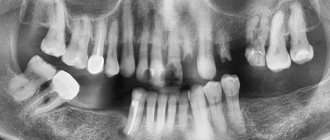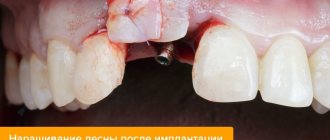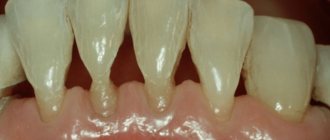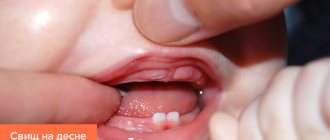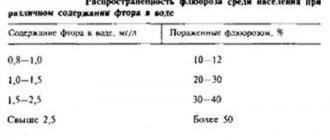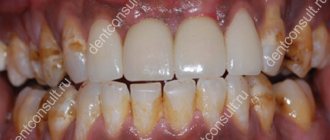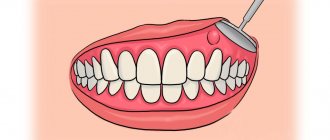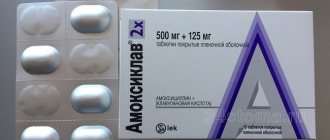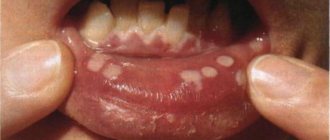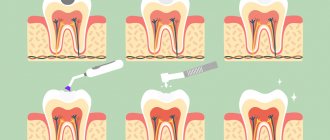The health of teeth, gums and oral cavity depends on a huge number of factors that combine a person’s lifestyle in general and the influence of the environment on his health. To one degree or another, the following elements have a direct impact on dental health:
- Nutrition. Diet, quality and nature of foods consumed affect the condition of teeth. Tooth enamel is sensitive to drinks and food that are too hot or too cold; excessively hard foods can damage the integrity of the tooth.
- Hygiene. If the rules of oral hygiene are not followed, pieces of food that are not removed become the cause of bacterial growth, provoking the process of rotting. Improper brushing of teeth contributes to the accumulation of plaque, the formation of tartar, etc.
- Diseases. Inflammatory processes in the oral cavity or nasopharynx can aggravate existing dental problems or provoke the emergence of new ones. In addition, chronic infection weakens the body's defenses, reducing immunity.
- Environmental factors. The quality of water used for cooking and consumption directly affects the condition of the oral cavity and the body as a whole.
In our Dentistry on Shchelkovskaya Diamed, dentists successfully treat diseases of the teeth and gums. We strongly recommend that if you experience pain, inflammation or other unpleasant sensations, contact the dentist immediately! Do not delay your visit to the doctor, this way you increase the chance of saving your natural tooth and avoiding extraction. You can make an appointment with a dentist by phone or by filling out an online appointment form. We are within walking distance from Shchelkovskaya m.
Gingivitis
Gingivitis is the earliest stage
of gum disease. According to various estimates, three quarters of adults show signs of this disease. Gingivitis develops due to the active activity of bacteria that live in dental plaque or tartar at the edge of the gums and in the gingival or periodontal canal.
Listen to the expert
Edith Kuzmina, head of the Department of Prevention of Dental Diseases at Moscow State Medical University, talks about how to keep your gums healthy. Remember, prevention is easier than cure. Preventing gum disease is your choice.
Exacerbation of periodontitis
With exacerbation of periodontitis, the process of asymptomatic and prolonged inflammation becomes active. In this case, acute pain, swelling of the gums, and swelling of the soft tissues of the face occur. The reasons for exacerbation of periodontitis include the following.
- Damage to the membrane of the focus of purulent inflammation.
The area of inflammation in granulomatous periodontitis is limited to dense tissue, resembling a pus-filled sac. Excessive pressure on the tooth can cause rupture of this membrane and the release of infection beyond the capsule, which leads to exacerbation of inflammation.
- Impaired drainage of pus from the site of inflammation.
While pus can leave the area of inflammation through a fistula or through root canals and then into a carious cavity, the process develops almost asymptomatically and imperceptibly. But if the fistula closes or the root canals become clogged (for example, with food particles), pus begins to accumulate, pain, swelling, etc. occur.
- Decrease in the body's defenses.
As a result of decreased immunity, the factors that restrained the growth of infection in the periodontal tissue of the tooth begin to weaken. This leads to the active development of infection and exacerbation of the inflammatory process.
Up to contents
Why does gingivitis develop?
The development of gingivitis is caused by:
- Incorrect or infrequent use of a toothbrush or dental floss
- Plaque in hard-to-reach areas, such as around wisdom teeth, dentures, or braces
- Irregular growth of teeth that overlap each other
- Medicines that cause dry mouth or swollen gums
- Insufficient functioning of the salivary glands
- Smoking and chewing tobacco
- Pregnancy
Early signs of gingivitis include bad breath, red, swollen or inflamed gums, and bleeding after brushing or flossing. People, as a rule, do not pay attention to these signs in vain. If you notice similar symptoms, make an appointment with your dentist! If gingivitis is left untreated
or treated incorrectly, it progresses to periodontal disease, a disease whose consequences are irreversible and often lead to tooth loss.
Unlike periodontal disease, gingivitis is a reversible condition
. It is easily treated by removing plaque, tartar, and using an antibacterial mouthwash. Your dentist will be able to determine the extent of gum damage and determine the treatment plan that is right for you.
Gingivitis is an inflammation of the gums that occurs due to the accumulation of a large number of bacteria in the oral cavity. When inflammation spreads to other tissues surrounding the teeth, with the development of periodontitis and without appropriate treatment, it can lead to tooth loss.
What is the difference between gingivitis and periodontitis?
Gingivitis (inflammation of the gums) usually precedes periodontitis - inflammation of the tissues surrounding the teeth: cementum, periodontal tissue and bone tissue. However, gingivitis does not always progress to periodontitis.
At the early stage of the disease, due to the accumulation of microbes and plaque on the teeth, the gums become inflamed. They become red and swollen and often bleed when brushing your teeth. And although the irritation of the gums can be quite severe, the teeth are still firmly seated in their alveoli. At this stage of the disease, there is no irreversible damage to the bone or other tooth tissues - this is gingivitis.
If gingivitis is not treated, it can progress to periodontitis. With periodontitis, the alveolar process of the jawbone is destroyed, and the gums separate from the teeth, forming pockets. In these pockets between the teeth and gums, food debris can accumulate and pathogenic microflora can develop. Inflammation begins as a response from the body.
Toxins produced by bacteria, along with substances and cells that help fight infection, as well as tissue breakdown products at the site of inflammation, begin to destroy the bone and connective tissue that holds teeth in place. As the disease progresses, the gum pockets become larger and more connective tissue and bone are destroyed. The teeth begin to become loose and then fall out.
Causes of gum inflammation.
The main cause of gum inflammation is the activity of bacteria that make up plaque.
Other factors contributing to periodontal inflammation:
- hormonal changes that occur during pregnancy, puberty, menopause, and in the monthly cycle make the gums more sensitive and susceptible to inflammation;
- various diseases can also affect the condition of the gums (cancer and HIV infections, which weaken the immune system, diabetes);
- some medications affect the condition of the oral cavity due to a decrease in the production of saliva, which has a protective function for teeth and gums; anticonvulsants and heart medications can cause pathological enlargement of the gums;
- bad habits, such as smoking, interfere with the process of gum restoration;
- failure to practice good oral hygiene, such as brushing and flossing daily;
- genetic predisposition may also contribute to the development of gingivitis.
Periodontitis is an inflammatory disease of periodontal tissue. These tissues include everything that surrounds the tooth: gums, bone, periodontium (the ligament of the tooth that fixes it in the socket). With this disease, symptomatic gingivitis develops with pathological changes in deeper tissues hidden from our eyes. Periodontitis, the photo of which you see below, can lead to the loss of several or all teeth, joint diseases, malocclusion and even deafness.
Healthy periodontium and its diseases.
In order to understand what periodontitis is, looking at a picture will not be enough. This is a rather insidious disease that greatly affects the oral health and psycho-emotional state of a person.
Causes of periodontitis development.
Gingivitis and periodontitis.
Most often, periodontitis and gingivitis are most closely related. Gingivitis is caused by poor hygiene, injuries, bacterial and viral lesions, changes in hormonal levels, vitamin deficiencies, and diseases of many organ systems (especially with pathologies of the endocrine and hematopoietic systems).
Periodontitis and gingivitis.
The differences between these diseases lie only in the state of the periodontal groove: with gingivitis, the ligament of the tooth at its neck is not damaged, but with periodontitis it is already destroyed and the pathological process spreads deeper towards the root of the tooth, accompanied by the destruction of all tissues that it encounters.
Malocclusion leads to chronic periodontal trauma, gum inflammation and loose teeth.
This is how a secondary traumatic bite develops, which only aggravates the situation. A pathological chain arises, which can only be broken by splinting for periodontitis. It is carried out using filling materials, special mouth guards, or orthopedic structures. It all depends on the degree of periodontitis, tooth mobility, the age and needs of the patient, and the clinical situation.
Splinting teeth to prevent periodontitis.
The etiology of periodontitis can only be in the presence of periodontopathogens - microorganisms that are most often found in periodontal pockets, disorders of gum trophism (with atherosclerosis), decreased immunity or removal of teeth in the oral cavity (then the remaining teeth take on all the chewing pressure and are overloaded).
Predisposing factors for the onset of the disease.
Typically, periodontitis occurs in people aged 30-40 years, but it can also develop in younger people due to changes in the functioning of the endocrine system and certain diseases. Thus, juvenile periodontitis, periodontitis in pregnant women, diabetes mellitus and many other forms are often found.
The most common reason for the involvement of periodontal tissue in the pathological process is poor hygiene, namely hard dental deposits. Irrational fillings and prosthetics also contribute to periodontitis. Overhanging edges of fillings and poorly cemented or poorly fitting crowns themselves cause chronic injury and inflammation. Plaque accumulates under them, which, saturated with minerals, turns into stone and “grows” deeper, pushing apart the soft tissues, destroying the periodontium.
Tartar.
Tartar can be supra- and subgingival. It is the subgingival tissue that not only injures the inner surface of the periodontal sulcus, but also traps food particles and bacterial plaque.
Symptoms of periodontitis.
The most obvious signs of periodontitis are:
X-ray changes in periodontal structures: bone prolapse, bone resorption, change in bone pattern due to inflammation;
Clinical symptoms:
- Inflammation and bleeding of the gums in the area of several (up to 3) teeth or the entire jaw with damage to the periodontal sulcus;
- There may be suppuration from periodontal pockets;
- The gums are red and swollen in acute cases and pasty and dark in chronic cases;
- Tooth mobility;
- Recession of the gums, exposure of the necks of the teeth, which may have wedge-shaped defects;
- Unpleasant sensations when chewing and at rest, bleeding from the gums, unpleasant odor.
As you can see, periodontitis in the photo is less unpleasant than in reality.
What is the prevention of periodontitis?
To begin with, you should be attentive to any changes in the gums. Bleeding and swelling can be symptoms of both gingivitis and periodontitis. The sooner they are diagnosed, the greater the likelihood of maintaining the disease in a compensated form, if not completely cured.
Regular preventive examinations and hygiene procedures will allow you to remove dental plaque, polish your teeth (this is necessary so that plaque does not linger on them), detect bad overhanging fillings in time and determine the decementation of crowns and bridges in the oral cavity, their negative impact on the health of the gums.
Regular examination allows you to detect periodontal disease at an early stage
Selection of personal hygiene products by professionals. Pastes, brushes, irrigators, dental elixirs, herbal rinses and anti-inflammatory ointments for gums should be selected by a doctor based on the health of your gums. Some components are contraindicated during hormonal changes, some of them are not used in adolescents and pregnant women, so it is better to consult not with a pharmacist at the pharmacy, but with a dentist after studying your clinical situation.
What causes periodontal disease?
The causes of periodontal disease are the same as those of gingivitis: poor oral hygiene, anatomical features and smoking. With periodontal disease, the active growth of bacteria causes the release of toxins, which, in turn, provoke an inflammatory process. It leads to the destruction of gum tissue - the gingival grooves around the tooth become deeper, forming periodontal pockets. They continue to accumulate plaque and food debris - an ideal environment for the development of bacteria. Often, the symptoms of periodontal disease go unnoticed until gum decay leads to tooth loss.
Types of periodontitis
Acute periodontitis
- Reasons for appearance.
Acute periodontitis of the tooth develops as a result of the action of pathogenic microflora, where streptococci, sometimes pneumococci and staphylococci predominate. In addition to the listed microbes, in marginal periodontitis there is a large number of spirochetes. In acute serous periodontitis, the inflammatory process begins after infection penetrates through a hole in the apex of the tooth, or less often through a pathological periodontal pocket.
- Signs.
During an exacerbation of the disease, tooth pain occurs, which intensifies when chewing, pressing on it or tapping (percussion) on the cutting or chewing surface. Characterized by a feeling of lengthening or “growing” of the tooth. If you press on the tooth for a long time, the pain subsides a little. If periodontitis is left untreated, the pain becomes throbbing and almost continuous. As a result of pressure on the tooth, heat, biting, and the patient taking a horizontal position, the pain intensifies.
Chronic periodontitis
- Reasons for appearance.
If left untreated, the acute inflammatory process always develops into a chronic form of the disease. Chronic periodontitis includes periods of exacerbation and subsidence of inflammation. An exacerbation of the disease occurs as a result of hypothermia, trauma, stress, etc. In this case, inflammation develops quite quickly, since the periodontal tissue is already damaged. The chronic form of the disease is more severe compared to the acute form.
- Signs.
In the chronic form, there is a change in the position of the teeth, an increase in the degree of their mobility and the appearance of interdental gaps. If there is no comprehensive treatment, abscesses develop, suppuration and acute pain occur. The gums surrounding the diseased tooth become swollen and red. With exacerbation of periodontitis, bleeding gums may occur even at night. If you do not receive treatment in a timely manner, you may experience an increase in body temperature and a deterioration in the general condition of the body.
Up to contents
Forms of periodontal disease
We brush our teeth correctly
What could be so difficult about brushing your teeth?
Nothing if you do everything right. We have compiled step-by-step instructions especially for you. Aggressive periodontal disease
develops very quickly in healthy people.
It is fleeting and leads to gum destruction and tooth loss. Chronic periodontal disease
is the most common form of the disease.
It is mainly observed in adults and develops gradually - from gum inflammation to tooth loss. Chronic periodontal disease often develops together with other diseases. Heart disease, diabetes and some forms of arthritis are closely linked to gum disease, according to scientists. Necrotizing periodontal disease
results in the complete death of gum tissue, connective tissue and bone that surround the teeth. It is most often observed in people with HIV infection, immunodeficiency conditions and malnutrition. Treatment of periodontal disease should be carried out under the close supervision of a dentist. Without treatment, it can result in tooth loss and gum tissue dying.
Symptoms of periodontitis
Painful sensations.
Periodontitis is characterized by aching pain in a specific tooth. Lightly tapping or biting on the tooth increases the pain. If periodontitis is left untreated, purulent inflammation develops and tearing, throbbing pain appears in the tooth.
Swelling of the gums.
If periodontitis becomes chronic, the gums surrounding the tooth may become red, swollen and painful.
If treatment is not started in a timely manner, a small wound may appear on the gum, from which pus will periodically leak, and the pain will decrease or completely disappear. This forms a fistula - a passage for the outflow of pus from the site of inflammation.
Deterioration of general condition.
Another symptom of periodontitis that has become chronic is a deterioration in general health, the appearance of weakness, fever, and sleep disturbances. When chewing, acute pain occurs, so patients often refuse to eat.
Up to contents
What is the difference between periodontitis and periodontal disease?
Periodontal disease, unlike periodontitis, is not associated with inflammation. This disease leads to a decrease in the volume of gingival tissue and atrophy of the alveolar processes due to poor circulation and nutrition. Atrophy of periodontal tissues is caused by:
- atherosclerotic changes in the arteries supplying the jaw;
- insufficient immunity;
- hormonal disorders, menopause, old age;
- malocclusion;
- diabetes mellitus, metabolic disorders;
- autoimmune diseases;
- unbalanced diet, lack of vitamins and minerals.
As a result of destructive periodontal changes:
- the dentition becomes ugly;
- In some places, the necks and even the roots of the teeth are exposed, and they become loose.
- increased sensitivity and pain occurs in response to temperature and mechanical stimuli;
- the risk of caries increases below the neck of the tooth, in the root area.
The addition of infection complicates the course of the disease. Diffuse periodontitis may develop, in which it is necessary to remove several teeth, periodontal abscesses and fistulas appear.
The progression of the disease leads to osteomyelitis of the jaw, so periodontal disease should be treated as early as possible. The consequences of these diseases are the same - loss of healthy teeth, destruction of bone tissue. But, if periodontitis is more often local, then periodontal disease is always a generalized disease affecting all teeth of the lower and upper jaw. With periodontal disease, gum pockets do not form.
Periodontal disease progresses more slowly, but its cause is more difficult to identify and eliminate. What to do if a tooth becomes mobile? First of all, be patient - complex, complex and lengthy treatment will be required.
Treatment of periodontitis
Therapeutic treatment
To begin with, the root canals are mechanically cleaned of remnants of pathogenic tissue. This procedure is carried out with special instruments using an antiseptic. After cleaning, antibacterial agents are used. The drug is placed at the mouth of the root canals. Usually this procedure has to be carried out repeatedly: the product is left for a day and then replaced with a new portion. In the treatment of chronic periodontitis, drugs that stimulate periodontal regeneration (restoration) are also used. Sometimes a course of physiotherapy is prescribed, which may include ultraphonophoresis, electrophoresis, microwave, UHF, magnetic or laser therapy.
Antibiotics can be used as local therapy, for example, for deep periodontal pockets. At the end of periodontitis treatment, the root canal is filled with permanent material, the selection of which is carried out individually and also depends on the structure of the canal.
Surgery
If the inflammatory process is severe or therapeutic methods of treatment have not brought the desired result, surgical intervention becomes necessary. In this case, resection of the apex of the tooth root is performed. The surgeon makes a small incision in the gum and peels away the mucous tissue near the tooth to gain access to the bone. He then removes the infected tissue along with the root tip. After this, the top of the root canal is filled, and sutures are placed on the mucosal tissue, which ensures proper healing. The process of bone regeneration near the root apex usually takes a month. If treatment for periodontitis does not produce a positive result or the disease is already advanced, tooth extraction may be required.
METROGYL DENTA® contains an optimal combination of metronidazole and chlorhexidine, due to which the drug acts on the main microorganisms that cause inflammation. METROGYL DENTA® is used in the complex treatment of dental periodontitis.
Up to contents
The information in this article is for reference only and does not replace professional advice from a doctor. To make a diagnosis and prescribe treatment, consult a qualified specialist.
Stages of development of the disease process
- First, soft plaque is deposited. If not removed, after three days it turns into a hard dental plaque. Tartar is formed, in the porous structure of which a huge number of pathogenic bacteria settle.
- Gingivitis begins - tartar chronically irritates the gums, which swell, thereby creating an even deeper pocket where even more tartar is deposited. The gums begin to bleed, so the person stops brushing his teeth, which further aggravates the course of gingivitis.
- The next stage in the development of the disease is periodontitis, when periodontal pockets form, disrupting the connection of the tooth with the base. Teeth with periodontitis become more and more loose. Sometimes purulent cavities form, which have to be treated surgically.
- Periodontal disease is the final stage in the development of the disease. By the way, atrophic gingivitis is considered its first sign. Bone tissue is destroyed and the teeth can no longer be strengthened - they have to be removed (or they fall out on their own).

